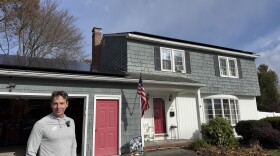As New Hampshire’s coastline prepares for a world with rising seas and stronger storms, communities and homeowners have different options, none of them simple: seawalls, raised structures, a retreat from the shoreline.
But some scientists in New Hampshire are pitching a more natural approach. All it takes is a little grass and some time.
“You just want to come up to a plant, go a few inches next to it, go down a few inches next to it, go straight down if you can…”
Armed with gardening gloves and a small shovel, UNH scientist Alyson Eberhardt digs on hands and knees in a small field of beach grass on Hampton Beach.
“…and then lift up, and then that’s it.”
Around her, a handful of people stand in a half circle, watching and learning. They’re here for a kind of gardening lesson that, in theory, could save their homes.
“Remember that this is a plant well-adapted to burial, so you can bury it pretty deep…”
It’s a lesson on how to plant beach grass, the kind you see sprouting from the tops of sand dunes.

You may not think much about sand dunes – just another obstacle on your way down to the water.
But for people interested in coastal resiliency – that is, how well a shoreline can cope with major storms, sand dunes are great. They offer protection from storm surge and flooding and compared to things like seawalls, they are really cheap.
Sand dunes are created naturally by ocean winds sweeping sand up the beach. Beach grass aids that process by acting as a sort of net, catching the sand as it blows by.
In places like Seabrook, many homes have a dune in between them and the ocean. But many don’t.
Eberhardt and other scientists with the New Hampshire Coastal Adaptation Workgroup, like Dave Burdick, are trying to change that.
“If you’re at risk, you want to capture that sand. You don’t want it to blow away. You don’t want it to blow in the street and have DPW come and take the sand away. You want to be able to capture that sand, because you want to protect your homes.”

But even though they are offering free beach grass to any homeowner who wants it, it can still be a tough sell.
Larry Deshler owns a house on the beach in Seabrook. He came to this workshop intrigued by the idea of a sand dune in his yard.
“Just to know what my options are for protecting my property.”
But there’s one big hang-up for him -- and for a lot of homeowners: once you plant beach grass, you can’t pull it. At least, not without permission from the state.
That’s because sand dunes are protected in New Hampshire under wetland regulations.
And remember, dunes are natural systems that grow and sometimes move on their own. That’s what worries Deschler. If he starts planting beach grass now, in a few years he could have a dune tall enough to block his view of the Atlantic, and he fears, reduce his home’s value.
“If I would be allowed to keep it low enough that it still protects my property’s value and high enough that it still protects my property, that’d be good.”
But Seacoast realtors will tell you more and more homebuyers are interested in beach houses that do have sand dunes.
It’s part of cultural shift of opinion on sand dunes that’s thanks in part to Superstorm Sandy.
Sandy’s storm surge devastated entire communities on the east coast, but not all of them.
Gary Engelstad is mayor of Bradley Beach, New Jersey, a town that was largely spared because of its sand dune.
“We were back in business the following day while other towns, they were like zombies. They went out and looked at their beach and it was gone.”
Engelstad says after the storm some of the residents who had earlier complained about the height of the dune called him to apologize.
“So yeah, the skeptics were not skeptics anymore.”
Back in New Hampshire, Eberhardt and other scientists are hoping to instill a similar love of sand dunes – without a big storm to make their point.
And they are making progress. At the end of this workshop, two homeowners decide to take some beach grass with them for their sand dunes.
But those homeowners already had dunes -- they’re just hoping to strengthen them. And others like Larry Deschler, who was concerned about his property value, decided to hold off -- at least for now.
“I don’t want to start something that goes out of my control.”
Alyson Eberhardt, the UNH scientist leading the workshop, says they’ve always known this would be an uphill climb.
“I mean you can see why it can be a tough decision. You know, looking at it from a coastal resilience perspective – no brainer. Looking at it from a, ‘I have this incredible beach and this view and this will compromise my ability to enjoy it,’ – I get that too.”
She says all they can do is hope to win over homeowners and build a more resilient beach, one yard at a time.








